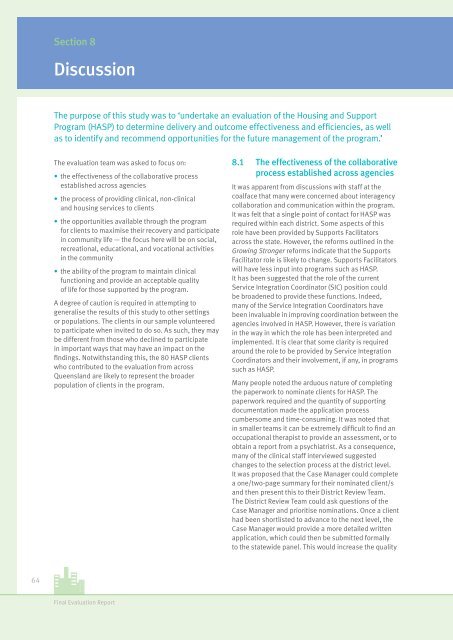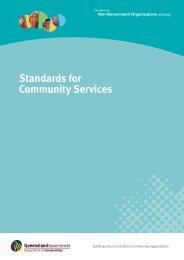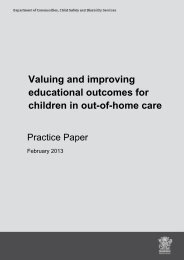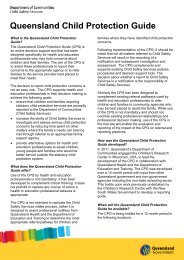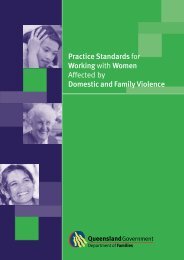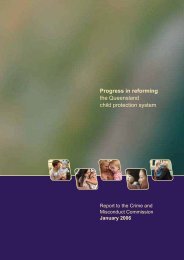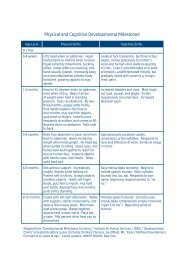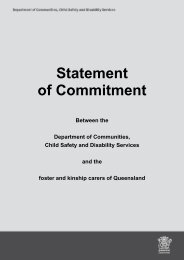Housing and Support Program (HASP): Final Evaluation Report
Housing and Support Program (HASP): Final Evaluation Report
Housing and Support Program (HASP): Final Evaluation Report
Create successful ePaper yourself
Turn your PDF publications into a flip-book with our unique Google optimized e-Paper software.
64<br />
Section 8<br />
Discussion<br />
The purpose of this study was to ‘undertake an evaluation of the <strong>Housing</strong> <strong>and</strong> <strong>Support</strong><br />
<strong>Program</strong> (<strong>HASP</strong>) to determine delivery <strong>and</strong> outcome effectiveness <strong>and</strong> effi ciencies, as well<br />
as to identify <strong>and</strong> recommend opportunities for the future management of the program.’<br />
The evaluation team was asked to focus on:<br />
the effectiveness of the collaborative process<br />
established across agencies<br />
the process of providing clinical, non-clinical<br />
<strong>and</strong> housing services to clients<br />
the opportunities available through the program<br />
for clients to maximise their recovery <strong>and</strong> participate<br />
in community life — the focus here will be on social,<br />
recreational, educational, <strong>and</strong> vocational activities<br />
in the community<br />
the ability of the program to maintain clinical<br />
functioning <strong>and</strong> provide an acceptable quality<br />
of life for those supported by the program.<br />
A degree of caution is required in attempting to<br />
generalise the results of this study to other settings<br />
or populations. The clients in our sample volunteered<br />
to participate when invited to do so. As such, they may<br />
be different from those who declined to participate<br />
in important ways that may have an impact on the<br />
fi ndings. Notwithst<strong>and</strong>ing this, the 80 <strong>HASP</strong> clients<br />
who contributed to the evaluation from across<br />
Queensl<strong>and</strong> are likely to represent the broader<br />
population of clients in the program.<br />
<strong>Final</strong> <strong>Evaluation</strong> <strong>Report</strong><br />
8.1 The effectiveness of the collaborative<br />
process established across agencies<br />
It was apparent from discussions with staff at the<br />
coalface that many were concerned about interagency<br />
collaboration <strong>and</strong> communication within the program.<br />
It was felt that a single point of contact for <strong>HASP</strong> was<br />
required within each district. Some aspects of this<br />
role have been provided by <strong>Support</strong>s Facilitators<br />
across the state. However, the reforms outlined in the<br />
Growing Stronger reforms indicate that the <strong>Support</strong>s<br />
Facilitator role is likely to change. <strong>Support</strong>s Facilitators<br />
will have less input into programs such as <strong>HASP</strong>.<br />
It has been suggested that the role of the current<br />
Service Integration Coordinator (SIC) position could<br />
be broadened to provide these functions. Indeed,<br />
many of the Service Integration Coordinators have<br />
been invaluable in improving coordination between the<br />
agencies involved in <strong>HASP</strong>. However, there is variation<br />
in the way in which the role has been interpreted <strong>and</strong><br />
implemented. It is clear that some clarity is required<br />
around the role to be provided by Service Integration<br />
Coordinators <strong>and</strong> their involvement, if any, in programs<br />
such as <strong>HASP</strong>.<br />
Many people noted the arduous nature of completing<br />
the paperwork to nominate clients for <strong>HASP</strong>. The<br />
paperwork required <strong>and</strong> the quantity of supporting<br />
documentation made the application process<br />
cumbersome <strong>and</strong> time-consuming. It was noted that<br />
in smaller teams it can be extremely diffi cult to fi nd an<br />
occupational therapist to provide an assessment, or to<br />
obtain a report from a psychiatrist. As a consequence,<br />
many of the clinical staff interviewed suggested<br />
changes to the selection process at the district level.<br />
It was proposed that the Case Manager could complete<br />
a one/two-page summary for their nominated client/s<br />
<strong>and</strong> then present this to their District Review Team.<br />
The District Review Team could ask questions of the<br />
Case Manager <strong>and</strong> prioritise nominations. Once a client<br />
had been shortlisted to advance to the next level, the<br />
Case Manager would provide a more detailed written<br />
application, which could then be submitted formally<br />
to the statewide panel. This would increase the quality


